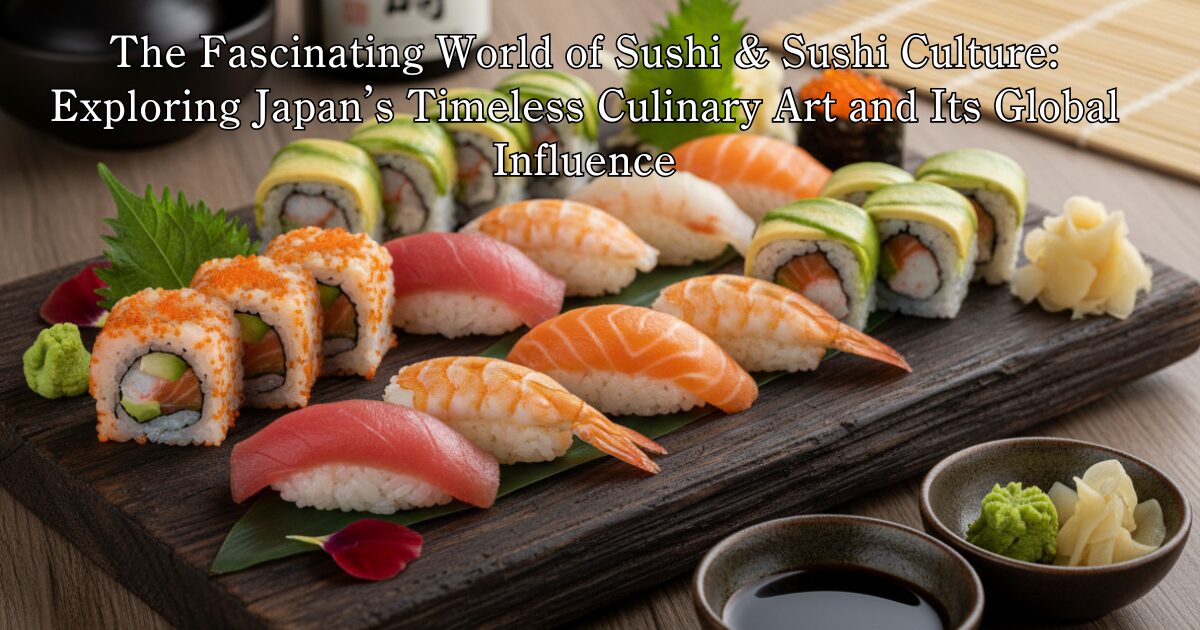Sushi is not just a meal—it is an experience, an expression of craftsmanship, and a reflection of Japan’s deep respect for nature and seasonality. Over the centuries, sushi has evolved from a simple preservation method to one of the world’s most beloved cuisines. Today, sushi represents a perfect balance between tradition and innovation, culture and creativity. In this article, we will dive into the rich world of sushi & sushi culture, exploring its origins, styles, etiquette, and the philosophy that makes it so unique.
- The Origins of Sushi: From Ancient Preservation to Refined Art
- Types of Sushi: A Delicious Variety Beyond Expectations
- The Art of Sushi Making: Skill, Precision, and Philosophy
- Sushi Etiquette: The Respectful Way to Enjoy Sushi
- Sushi & Sushi Culture Around the World
- The Health Benefits of Sushi
- The Future of Sushi: Innovation Meets Tradition
- Conclusion: Sushi & Sushi Culture as a Symbol of Harmony
The Origins of Sushi: From Ancient Preservation to Refined Art
Sushi’s story begins long before it became the elegant dish we know today. Originally, sushi was a means of preserving fish. In ancient times, people stored fish in fermented rice to keep it edible for longer periods. This early version, known as narezushi, was first recorded in Southeast Asia and eventually spread to Japan.
In Japan, this method evolved into hayazushi, where vinegar was added to the rice to mimic the sourness of fermentation, allowing the dish to be eaten immediately. Over time, chefs refined the process, creating sushi that celebrated the freshness of ingredients rather than fermentation.
During the Edo period (1603–1868), sushi took on its modern form in Tokyo (then Edo), where nigiri-zushi was invented. Small portions of vinegared rice topped with slices of fresh fish became a fast, portable meal for busy city dwellers. This innovation transformed sushi from preservation food into an edible art form—fresh, elegant, and deeply connected to Japan’s urban culture.
Types of Sushi: A Delicious Variety Beyond Expectations
Sushi is not limited to one shape or flavor—it is a diverse category with multiple regional styles. Here are some of the most popular types:
Nigiri-zushi: The classic hand-pressed sushi consists of an oval-shaped ball of vinegared rice topped with fresh seafood, often brushed with soy sauce.
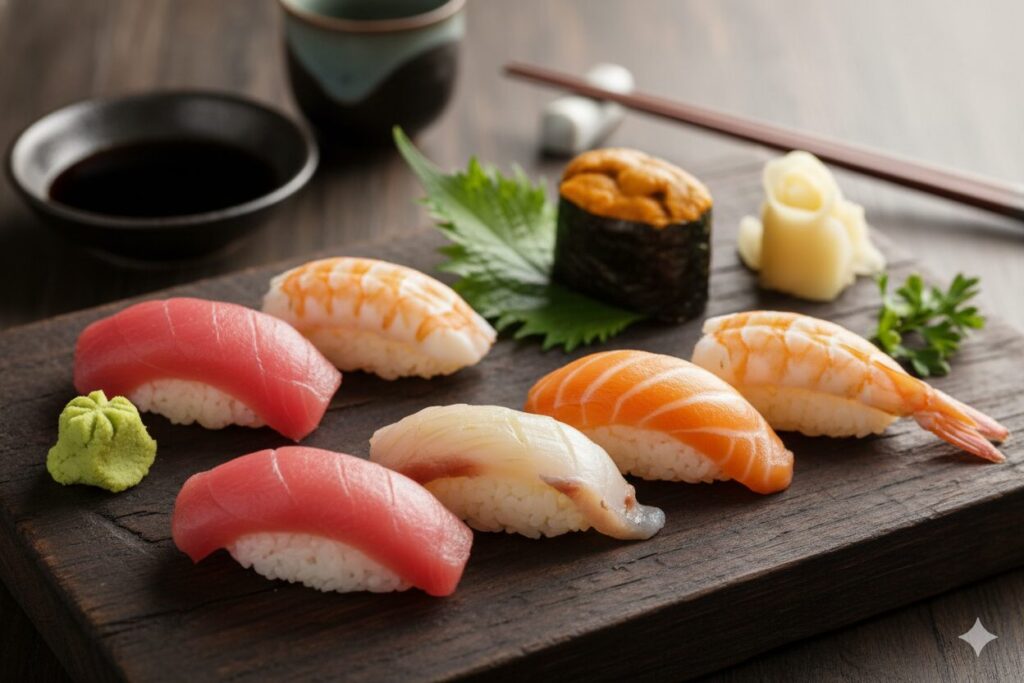
Maki-zushi: Rolled sushi wrapped in seaweed (nori) and sliced into bite-sized pieces. It includes varieties like futomaki (thick rolls), hosomaki (thin rolls), and uramaki (inside-out rolls popular in Western countries).
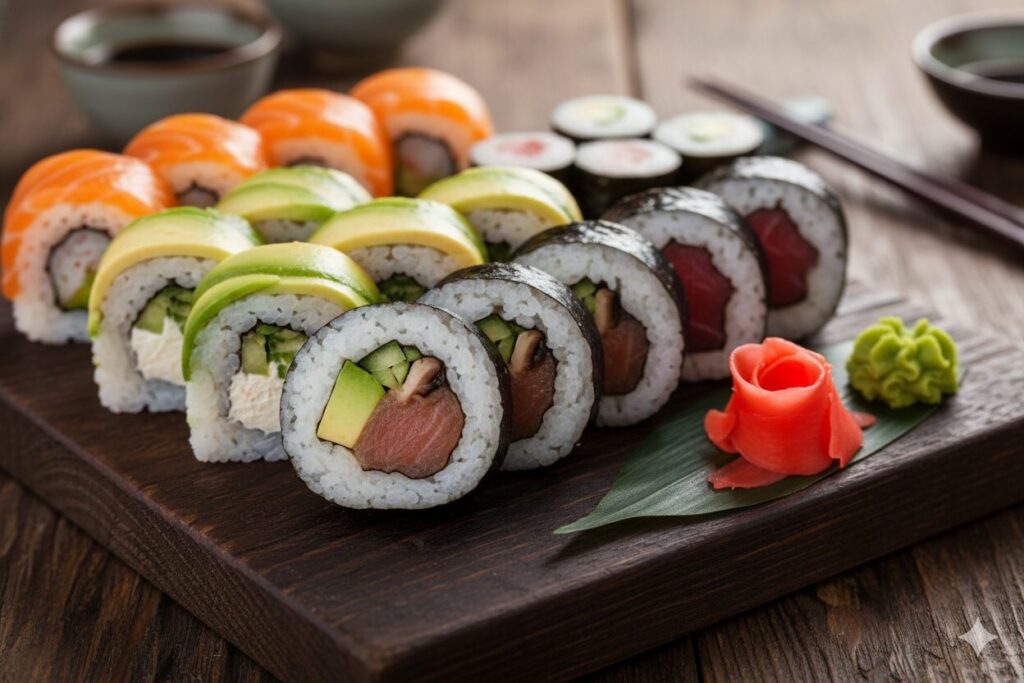
Temaki: A cone-shaped hand roll, wrapped in nori and filled with rice, fish, and vegetables, meant to be eaten with your hands.
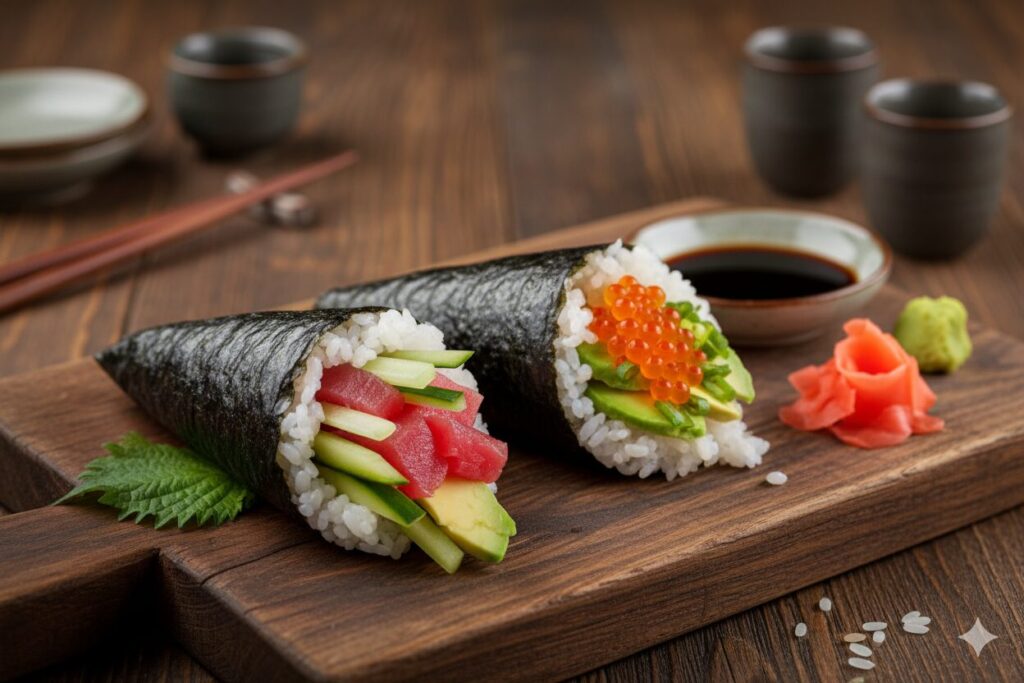
Oshi-zushi: A pressed sushi style from Osaka, where rice and fish are layered in a mold and cut into neat rectangular shapes.
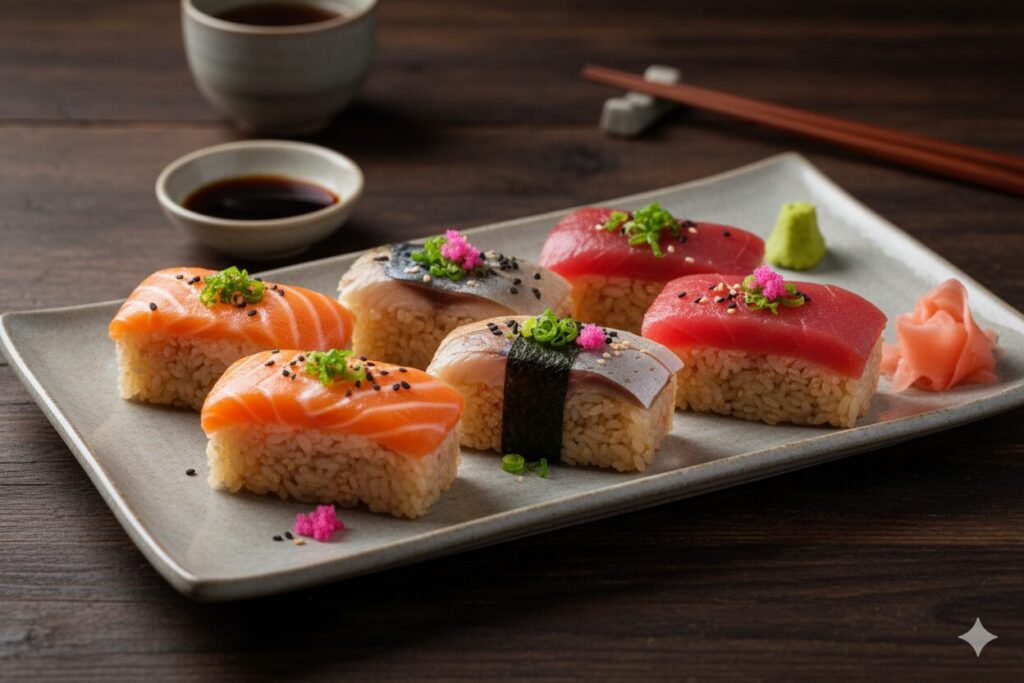
Chirashi-zushi: A bowl of vinegared rice topped with assorted seafood, vegetables, and garnishes, often served during celebrations.
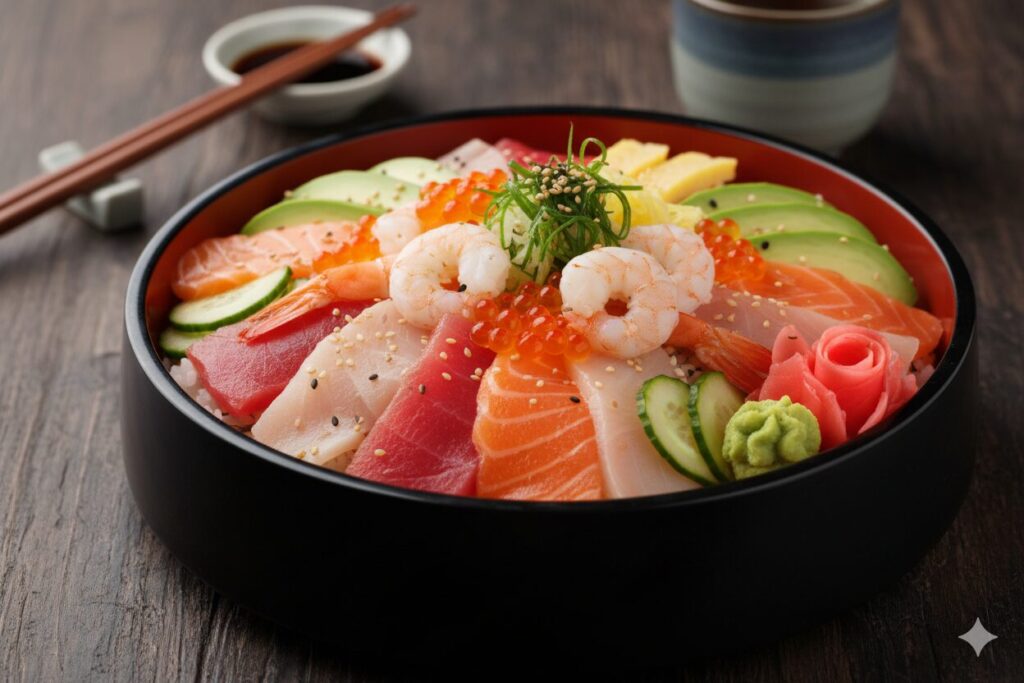
Each style reflects a different regional identity and historical background, demonstrating the adaptability and creativity of Japanese cuisine.
The Art of Sushi Making: Skill, Precision, and Philosophy
Making sushi is an art form that requires years of dedication. Sushi chefs, known as itamae, spend decades mastering the craft, learning not only the technical skills but also the philosophy behind each movement.
Every step—from washing the rice to slicing the fish—is guided by precision and mindfulness. The rice must be cooked to perfection, seasoned delicately with vinegar, salt, and sugar, and cooled at the right temperature. The fish must be handled carefully, respecting its texture and flavor.
In traditional sushi restaurants, simplicity is key. The beauty of sushi lies in its minimalism. The chef’s goal is to enhance, not overpower, the natural taste of each ingredient. This philosophy, rooted in Japanese aesthetics like wabi-sabi (the beauty of imperfection) and shun (seasonality), makes sushi a deeply cultural experience.
Sushi Etiquette: The Respectful Way to Enjoy Sushi
Sushi culture is not only about how it is made but also how it is eaten. Proper etiquette shows appreciation for the chef and the tradition. Here are a few essential points of sushi manners:
- Use your hands or chopsticks: Either is acceptable, but when eating nigiri-zushi, many Japanese prefer to use their hands.
- Dip fish-side first: When dipping sushi into soy sauce, turn it so that the fish, not the rice, touches the sauce to avoid soaking too much.
- Eat in one bite: Each piece of sushi is crafted for a single bite, balancing flavors perfectly.
- Respect the chef’s sequence: At a high-end sushi bar (omakase style), trust the chef’s order—it is designed to enhance your tasting experience.
- Ginger as a palate cleanser: The pickled ginger (gari) is meant to refresh your taste buds between different pieces, not to be placed on top of sushi.
This etiquette is more than just rules—it reflects mindfulness and respect, values deeply rooted in Japanese culture.
Sushi & Sushi Culture Around the World
Sushi’s global journey is a fascinating example of cultural exchange. What began as a Japanese street food has become a worldwide phenomenon, loved for its freshness, beauty, and health benefits.
In the United States, sushi became popular in the 1960s, with the creation of the California roll, a maki roll using avocado and crab stick, designed to suit Western palates. Since then, sushi has evolved in countless ways—fusion rolls, creative sauces, and even vegetarian or vegan sushi have emerged.
In Europe, sushi is appreciated for its artistry and balance, often seen as a symbol of sophistication. Meanwhile, in Southeast Asia, it has merged with local flavors, creating unique interpretations such as spicy tuna rolls or tempura rolls.
Despite these innovations, traditional sushi culture remains strong in Japan. The contrast between global adaptation and local authenticity highlights the cultural depth of sushi. It continues to evolve, yet its soul—respect for ingredients and craftsmanship—remains unchanged.
The Health Benefits of Sushi
Beyond its aesthetic appeal, sushi is also known for its nutritional value. It is a well-balanced meal that combines carbohydrates (rice), protein (fish), and minerals (seaweed), often with vegetables and wasabi.
Fish like salmon and tuna are rich in omega-3 fatty acids, which support heart health. Seaweed contains iodine and essential vitamins, while wasabi and ginger have antibacterial properties. Vinegared rice aids digestion, making sushi not only delicious but also a healthy choice when eaten in moderation.
However, balance is key. While sushi is nutritious, excessive soy sauce or fried rolls can increase sodium and calorie intake. Traditional sushi, focusing on raw fish and light flavors, remains the healthiest version of this beloved dish.
The Future of Sushi: Innovation Meets Tradition
As the world continues to change, so does sushi. Modern chefs are experimenting with new ingredients—plant-based fish alternatives, sustainable seafood, and artistic plating techniques. Technology is also entering the sushi world, with robots assisting in rice shaping and temperature control to ensure consistency.
Yet, despite these innovations, the essence of sushi culture endures. The relationship between chef, ingredient, and customer remains sacred. The spirit of omotenashi—Japanese hospitality—is at the heart of every sushi experience, whether in a Michelin-starred restaurant or a humble neighborhood shop.
Sushi’s future lies in balance: preserving its traditions while embracing creativity. It continues to bridge cultures, bringing people together through taste, artistry, and respect.
Conclusion: Sushi & Sushi Culture as a Symbol of Harmony
Sushi & sushi culture represent more than just food—they embody harmony between nature and human craftsmanship, simplicity and sophistication, tradition and modernity. Each bite carries centuries of history and cultural wisdom.
From the bustling streets of Edo to fine dining tables around the world, sushi continues to inspire admiration and curiosity. Whether you are enjoying a simple tuna roll or an exquisite omakase course, sushi invites you to slow down, appreciate the moment, and connect with a timeless culinary heritage.
In a world where trends come and go, sushi remains an enduring symbol of balance, beauty, and respect—an art that continues to evolve while staying true to its soul.

